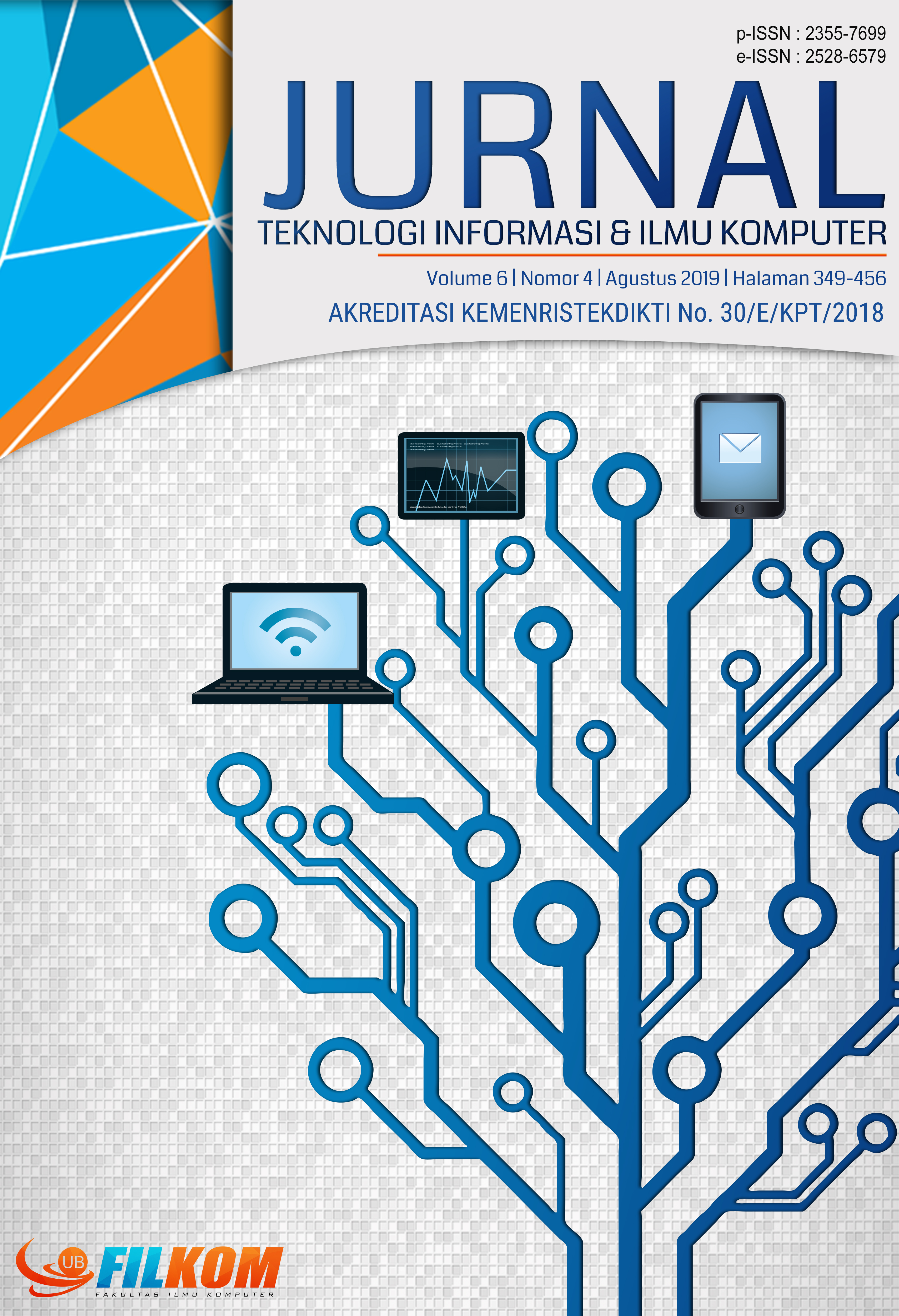Fuzzy Time Series dan Algoritme Average Based Length untuk Prediksi Pekerja Migran Indonesia
DOI:
https://doi.org/10.25126/jtiik.2019641177Abstrak
Perkembangan jumlah Pekerja Migran Indonesia (PMI) program Government to Government (G to G) Jepang bidang perawat (nurse) dan perawat orang berusia lanjut (care worker) mengalami naik turun dari tahun 2008 hingga 2018. Untuk dapat menganalisis jumlah PMI yang mengalami naik turun dengan mengukur perkembangan jumlah PMI saat ini dan memprediksikan kondisi tersebut pada masa mendatang, maka diperlukan model prediksi. Dalam penelitian ini diterapkan model fuzzy time series dengan menggunakan algoritme average-based length. Penentuan panjang interval yang efektif dapat mempengaruhi hasil prediksi yaitu dapat meningkatkan keakuratan yang tinggi dalam fuzzy time series. Hasil proses prediksi PMI program G to G Jepang tahun 2019 bidang nurse diperoleh 43.3, bidang care worker diperoleh 300 dan bidang keseluruhan diperoleh 325. Hasil uji kinerja prediksi PMI program G to G Jepang, menggunakan Mean Absolute Percentage Error (MAPE) adalah 24.27% untuk bidang nurse dengan nilai akurasi prediksi 20–50% termasuk dalam kriteria “wajar”, bidang care worker 11.29% dengan nilai akurasi prediksi 10–20% termasuk dalam kriteria “baik”, sedangkan untuk bidang keseluruhan diperoleh 8.41% dengan nilai akurasi prediksi MAPE <10% termasuk dalam kriteria “sangat baik”. Berdasarkan hasil prediksi tersebut dapat digunakan sebagai pendukung keputusan bagi manajemen dalam membuat kebijakan terkait persiapan, perencanaan, penjadwalan, penempatan, dan perlindungan terhadap para calon PMI pada masa mendatang. Dengan demikian dapat meningkatkan kualitas kinerja sumberdaya manusia dalam memberikan pelayanan terbaik terhadap para calon PMI program G to G Jepang.
Abstract
The development of the number of Pekerja Migran Indonesia (PMI) Government to Government programs (G to G) in Japan in the field of nurses and care workers experienced ups and downs from 2008 to 2018. To be able to analyze the number of PMIs experiencing ups and downs by measuring the development of the current number of PMIs and predicting these conditions in the future, a prediction model is needed. In this study fuzzy time series models are applied using an average-based length algorithm. Determining the length of an effective interval can influence the results of predictions, which can increase high accuracy in fuzzy time series. The results of the PMI program G to G Japan prediction process for 2019 in the nurse field were obtained 43.3, the care worker field was obtained 300 and the overall field was 325. The results of the G to G Japan PMI prediction performance test, using the Mean Absolute Percentage Error (MAPE) were 24.27% for nurse field with predictive accuracy value of 20–50% included in the criteria of "reasonable", the field of care worker 11.29% with a prediction accuracy value of 10-20% included in the criteria "good", while for the overall field obtained 8.41% with MAPE prediction accuracy value < 10% is included in the criteria of "very good". Based on the results of these predictions it can be used as a decision support for management in making policies related to preparation, planning, scheduling, placement, and protection of future PMI candidates. Thus it can improve the quality of the performance of human resources in providing the best service to prospective G-G Japan PMI programs.
Downloads
Referensi
ALADAG, C. H., YOLCU, U., EGRIOGLU, E., DALAR, A. Z., 2012. A new time invariant fuzzy time series forecasting method based on particle swarm optimization. Applied Soft Computing, Vol.12, pp.3291–3299.
ANGGODO, Y.P., MAHMUDY, W.F., 2016. Peramalan Butuhan Hidup Minimum Menggunakan Automatic Clustering dan Fuzzy Logical Relationship. Jurnal Teknologi Informasi dan Ilmu Komputer (JTIIK), Vol.3, No.2, pp.94-102.
BISHT, K., KUMAR, S., 2016. Fuzzy time series forecasting method based on hesitant fuzzy sets. Expert Systems with Applications, Vol.64, pp.557-568.
CHANG, P.-C., WANG, Y.-W., LIU, C.-H., 2007. The development of a weighted evolving fuzzy neural network for PCB sales forecasting. Expert Systems with Applications, Vol.32, pp.86–96.
HEIZER, J., RENDER, B., 2009. Manajemen Operasi. Buku 1 Edisi 9, Jakarta: Salemba Empat.
HUARNG, K.-H., YU, T.H.-K., 2012. Modeling fuzzy time series with multiple observations. Iternational Journal of Innovative Computing, Information and Control, Vol.8, pp.7415-7426.
LU, W., CHEN, X., PEDRYCZ, W., LIU, X., YANG, J., 2015. Using interval information granules to improve forecasting in fuzzy time series. International Journal of Approximate Reasoning, Vo.57, pp.1–18.
NUGROHO, N.A., PURQON, A., 2015. Analisis 9 Saham Sektor Industri di Indonesia Menggunakan Metode SVR. Seminar Kontribusi Fisika, Bandung.
SINGH, P., BORAH, B., 2013. An efficient time series forecasting model based on fuzzy time series. Engineering Applications of Artificial Intelligence, Vol.26, pp.2443–2457.
WANG, L., LIU, X., PEDRYCZ, W., 2013. Effective intervals determined by information granules to improve forecasting in fuzzy time series. Expert Systems with Applications, Vol.40, pp.5673-5679, issue 14.
XIHAO, S., YIMIN, L., 2008. Average-based fuzzy time series models for forecasting Shanghai compound index. World Journal of Modelling and Simulation, Vol.4, No.2, pp.104-111.
Undang-undang Republik Indonesia nomor 18 tahun 2017 tentang Perlindungan Pekerja Migran Indonesia. Jakarta: Kementerian Hukum dan Hak Asasi Manusia Republik Indonesia.
bnp2tki.go.id, 2018.
Retrived from
Data Penempatan dan Perlindungan PMI.
Retrived from
Unduhan
Diterbitkan
Terbitan
Bagian
Lisensi

Artikel ini berlisensi Creative Common Attribution-ShareAlike 4.0 International (CC BY-SA 4.0)
Penulis yang menerbitkan di jurnal ini menyetujui ketentuan berikut:
- Penulis menyimpan hak cipta dan memberikan jurnal hak penerbitan pertama naskah secara simultan dengan lisensi di bawah Creative Common Attribution-ShareAlike 4.0 International (CC BY-SA 4.0) yang mengizinkan orang lain untuk berbagi pekerjaan dengan sebuah pernyataan kepenulisan pekerjaan dan penerbitan awal di jurnal ini.
- Penulis bisa memasukkan ke dalam penyusunan kontraktual tambahan terpisah untuk distribusi non ekslusif versi kaya terbitan jurnal (contoh: mempostingnya ke repositori institusional atau menerbitkannya dalam sebuah buku), dengan pengakuan penerbitan awalnya di jurnal ini.
- Penulis diizinkan dan didorong untuk mem-posting karya mereka online (contoh: di repositori institusional atau di website mereka) sebelum dan selama proses penyerahan, karena dapat mengarahkan ke pertukaran produktif, seperti halnya sitiran yang lebih awal dan lebih hebat dari karya yang diterbitkan. (Lihat Efek Akses Terbuka).












